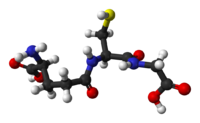
Photo from wikipedia
The present research was conducted to elucidate a possible molecular mechanism related to neuromodulatory effects of tannic acid (TA) supplementation against traumatic brain injury (TBI) in a rodent model. Oxidative… Click to show full abstract
The present research was conducted to elucidate a possible molecular mechanism related to neuromodulatory effects of tannic acid (TA) supplementation against traumatic brain injury (TBI) in a rodent model. Oxidative damage and neuroinflammation play a critical role in TBI and lead to behavioral alterations and neuronal dysfunction and death. These changes suggest a potential avenue in neurotherapeutic intervention. The aim of the present study was to investigate the neuroprotective effects of TA and potential mechanism of these effects in a controlled cortical impact injury model of TBI in Wistar rats that were treated with TA (50 mg/kg body weight. i.p. ) before 30 min and 6 and 18 h after TBI. TBI-induced rats were examined after 24 h for behavioral dysfunction, Nissl stain, lipid peroxidation rate, glutathione level, activities of antioxidant enzymes (catalase, glutathione S -transferase, glutathione peroxidase, and superoxide dismutase), the expression level of 4-hydroxynonenal, pro-inflammatory cytokines such as tumor necrosis factor alpha and interleukin-1 beta, as well as brain edema and immunoreactivity of glial fibrillary acidic protein. Results indicated that TA supplementation significantly modulated above mentioned alterations. Moreover, TA treatment effectively upregulated the protein expression of peroxisome proliferator–activated receptor gamma co-activator 1 alpha (PGC-1α) and nuclear factor-E2-related factor-2 (Nrf2) as well as mitochondrial transcription factor A and heme oxygenase-1 (HO-1) following TBI. Overall, our results suggest that TA effectively ameliorates the behavioral alterations, oxidative damage, mitochondrial impairment, and inflammation against TBI that may be attributed to activation of PGC-1α/Nrf-2/HO-1 signaling pathway.
Journal Title: Molecular Neurobiology
Year Published: 2020
Link to full text (if available)
Share on Social Media: Sign Up to like & get
recommendations!